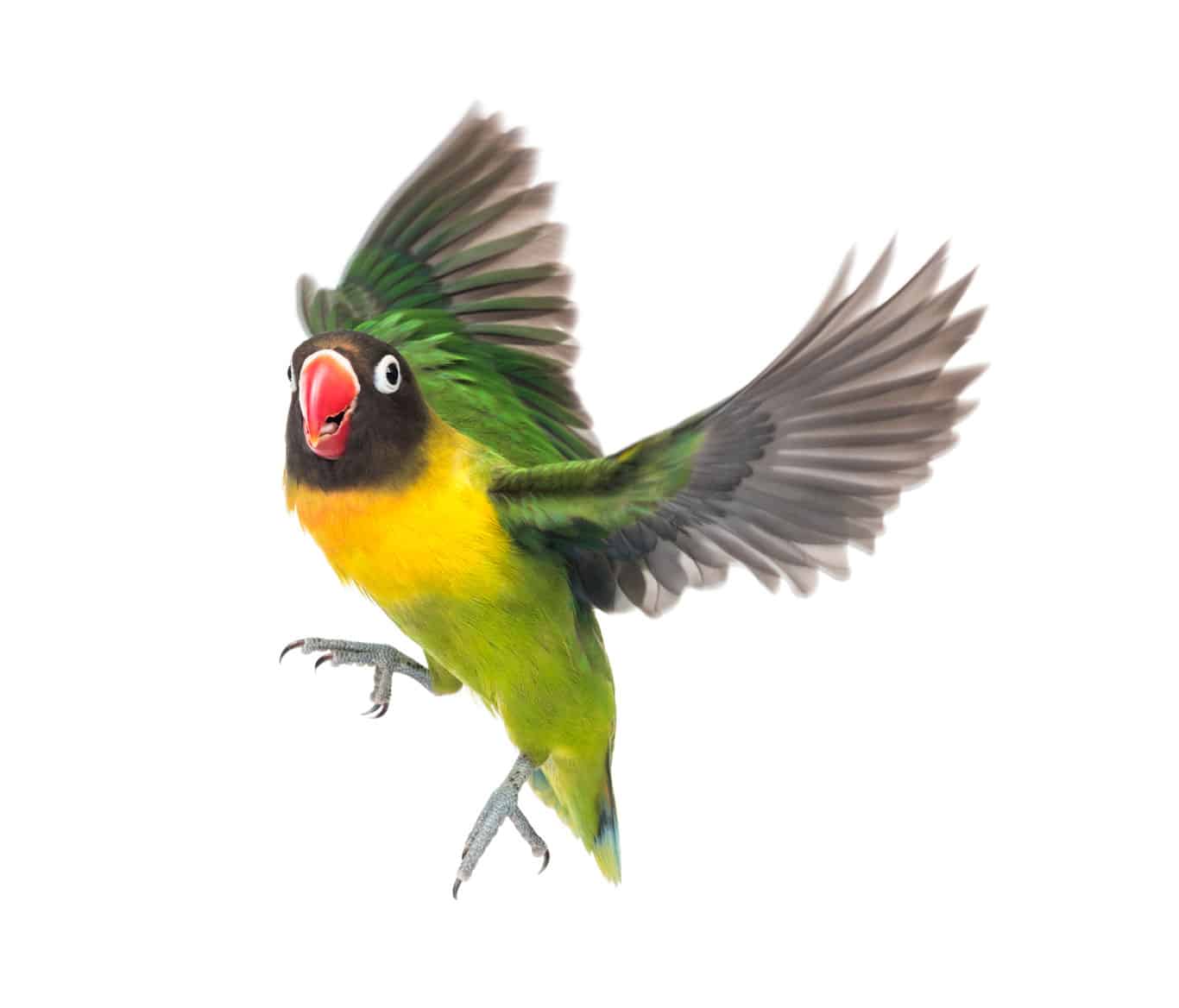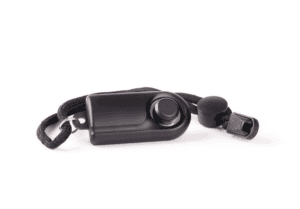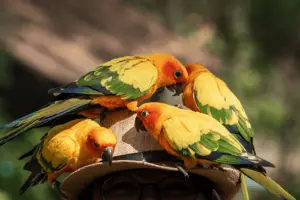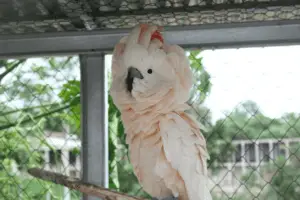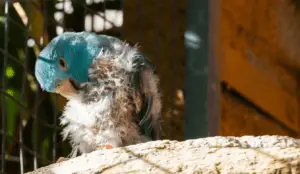For centuries, people have associated lovebirds with Valentine’s Day. And one of the most popular lovebirds is the black lovebird. The black lovebird, also known as the Black-cheeked lovebird, is one of the world’s smallest and most beautiful parrot species.
They’re known for making long-term relationships; unfortunately, they don’t speak like parrots. Instead, they make lots of noise and require a lot of care. So before adopting these beautiful birds, you should find out more about these birds.
The black-cheeked lovebirds are beautiful birds that make exceptional pets for individuals who know how to care for them. They thrive in a clean environment and require attention. The black lovebirds may not speak like most parrots; however, they make lots of noise. The Black lovebirds can live for over two decades with proper maintenance.
Black lovebirds are exceptional parrots that make great pets but can make lots of noise. Therefore, proper training is mandatory, and they’re not ideal for apartment life. Being part of the family, you must do everything for your pet’s safety. In this article, we’ll elaborate more about these birds and how to care for them. We’ll also talk about what we can do to improve the lifespan of these birds.
So let’s dive right in.
Black Lovebirds Overview
Despite being the world’s smallest parrot species, black lovebirds or black-cheeked lovebirds are adorable and lovable pets. They do well and thrive when kept in pairs. The black-cheeked lovebird gets its name from its facial coloring. The masked lovebirds and Nyasa and Fischer belong to a group of eye-ring lovebirds.
The Agapornis family comprises nine species of parrots, of which 4 have a distinctive white ring around their eyes. These parrots are commonly known as eye-ring lovebirds. Scientists consider this parrot a distinct species, although previously classified as a sub-species of the Lilian’s and Nyasa lovebirds. The Black lovebird is monotypic, and as aforementioned, at times, it’s considered a subspecies of Lilian’s lovebird.
The Agapornis nigrigenis is mainly greenish, with white eye-rings, a red beak, and a brown head. This parrot is listed as vulnerable by the IUCN as its population has been decreasing rapidly.
The leading cause of population decline is continuous habitat loss. The leading cause of habitat loss is the gradual desiccation of water.
It’s believed that there are around 9,999 mature black lovebirds available. Nature reserves are the only places where you can find these birds.
Habitat Of Black Lovebirds
The black lovebirds originate from southwestern Zambia and breed along the south-flowing parts of River Zambezi and the northern-flowing parts of River Kafue. These birds were not known to the Europeans until the 1900s.
But after being discovered, the Europeans started trapping and exporting them to Europe as a pet. Unfortunately, the poaching business continued for decades and has played a significant role in reducing their population.
Some of their previous inhabitants once popularized these birds in the wild but now consider them endangered. For instance, authorities believe that these lovebirds are extinct in the northern parts of Zimbabwe.
But the locals claim they have seen a few black lovebirds in the wild. Birdwatchers can also spot these birds in the wild in Botswana.
The Black lovebirds inhabit the deciduous woodlands in southern parts of Africa, where there is a permanent water supply. They can be found in the agricultural regions and acacia woodlands, with a regular water supply, besides the Mopane woodlands extending from Namibia to Angola.
During the dry seasons, you can gather a flock of about 800 black lovebirds in these regions. The gradual disappearance of water in their original habitats is threatening the declining population of these animals.
Appearance
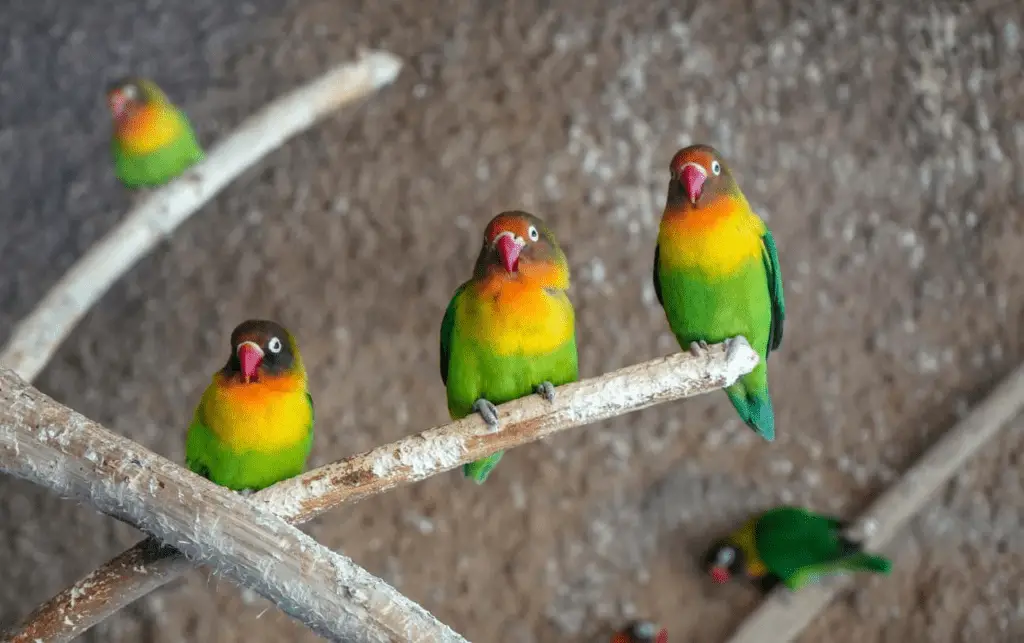
Compared to the other eye-ring lovebirds, the black-cheeked lovebird is the smallest bird in size. Some of this bird’s main features include:
- This lovebird is 5.5 inches long.
- It comes with greenish plumage.
- The Black lovebird has a reddish-brown forecrown forehead.
- It has a brownish-black throat and cheeks that stand out among other eye-ring lovebirds.
- These birds come with gray feet and white eye-rings unique to a few Agapornis species.
They have an orange bib that fades to a greenish-yellow below the throat. The adults have green plumage, while the young ones have dull ones. The beak of the adults is reddish, while the young ones are orange.
Temperament
When looking for a great bird, the first thing we always consider is its temperament. After all, its character determines whether it will get along with the other birds in your aviary, particularly during the mating season. Black Lovebirds’ temperament will also determine the amount of time you’ll spend training it.
Black lovebirds are territorial creatures, and this behavior can become even more evident when they share an aviary with other birds. So before introducing it to other birds in your aviary, you should spend more time taming it and then gradually present it to the other pets. And make sure they get along before leaving them alone in the aviary or the same cage.
Luckily, it does love playing games, and if well-trained, it can do lots of tricks. Remember, training is for more than just entertainment. Besides doing the new tricks, training is a bonding session between you two. These birds love companionship, and when left alone, they can become stressed.
So what can you do to keep these territorial creatures stress-free in your absence? Black lovebirds can be quite docile; therefore, you should avoid keeping them in an overcrowded aviary. At times when stressed, they can be pretty noisy.
Their high-pitched noises can be annoying, so you must do everything possible to keep them comfortable. It means providing them with more unique toys to keep them busy and wearing them down before you get home. A tired lovebird is less noisy, so that you won’t worry about its high-pitched shrill noise.
5 Ways To Take Care Of A Black Lovebird
Despite their docile nature and pleasing temperament, taking care of them can be very easy until they mature. So if you’re a first-time owner of black-cheeked lovebirds, you may wonder how to improve their lifespan. How can you prepare your home for the new black lovebirds? Well, for answers to these questions and more, please read on.
- Your Home For The Black Lovebirds
Before introducing these birds into your home, you should prepare where to place the cage. After all, you can’t just place the cage anywhere in the house; therefore, proper planning and house preparation is mandatory.
It would help if you placed the cage where you can control the temperature and keep it away from an open window. To protect your bird from fluctuating temperatures, keep the car’s heating when transporting them from the breeder to your home. So make sure you set aside enough room for your new pet.
On top of that, parrots can also be affected by a wide range of fumes, so you have to ensure that where you place them is away from certain harmful fumes. Fumes from the air freshener, paint, cleaning products, and tobacco products can affect the life of your pet. Therefore, you should consider the following factors when picking the location of the cage.
- Pick The Right Cage

Generally, when it comes to the parrot’s housing, there are several things you must do. When picking the cage, you should consider the durability of the materials used to make it and its size. The minimum requirement for a bird cage is 18″ by 18″ by 24″.
Luckily, there are many options for lovebirds on Amazon that can create a fantastic home for your pet. These birds love sitting and resting on a perch, so you should provide more than enough perches for the bird.
But most importantly, the cage should always be clean; therefore, you should have it cleaned daily. You should also clean all the cage’s components, including the water and food dishes, toys, and perches. The house temperature must not exceed 75 degrees Fahrenheit. Ensure you clean the cage and all your pet’s gear with fragrance-free detergent.
- Diet
Another crucial part of caring for these birds is feeding them the proper diet. It means a balanced diet that will keep your pet healthy and growing at the correct rate. Unfortunately, you can’t deviate much from the food it was consuming while the breeder’s place gave it. So you should find out exactly what the breeder was feeding it and continue with the same brand before switching later.
Generally, they feed on seeds growing at ground level, which is mostly grass seed. But they can also consume millet, sorghum, corn, insect larvae, and plant matter. So on top of the seed mix, you should give it minerals and vitamins. A cuttlebone or cuttlefish can help keep your pet healthy.
It’s a great source of calcium and minerals for your bird, which can come in handy when it starts laying eggs. The increase in calcium intake can help with eggshell formation.
- Care
Other than feeding it the right diet and proper housing, It would be best to guarantee it’s comfortable, which means mimicking its environment in the wild to some extent. Do your research and find out what your pet needs to thrive.
For instance, in the wild, they love playing in the water, so you should ] mist-spray your lovebirds twice every week.
On top of that, you should keep all the harmful things away from your pet. After all, it can be pretty adventurous when left alone, resulting in injuries.
- Breeding
Like some lovebirds, the black lovebirds attain sexual maturity at about ten months. At this stage, they create a lifelong partnership and courtship starts. However, they don’t have well-defined reproductive behavior, but they’re known for laying between 3 and 6 eggs. And once the eggs hatch, the chicks will stay with their parents for four weeks before leaving the nest.
Can Black-Cheeked Lovebirds Speak?
Generally, black lovebirds are parrots, but they can’t talk like most other species. Sure, they can mimic our sounds, but they prefer communicating using their shrieking loud voices. They tend to chatter with each other, which is why they need companions of the same or different species. Their loud shrieking noises make them a bad option for apartment dwellers.
Common Health Problems With The Black Lovebirds

Like most parrots in captivity, they can be pretty high maintenance; their talons require regular trimming. And to keep them happy and healthy, you should include a bird bath where they can play and get their feathers wet when necessary.
The black lovebird can be affected by several health issues, including:
- Drooping heads
- Plucking of feathers,
- Abnormal droppings,
- Poor appetite
- Respiratory problems.
Regular visits to the vet will help in catching any illnesses.
Conclusion
Black lovebirds make great pets that can improve the quality of your life. These birds can make your day after a challenging experience at work. Therefore, every bird owner should do everything humanly possible to keep your black lovebird happy and healthy.
It means providing a balanced diet, which includes more than just seed mix. On top of that, you should prepare your home for the pet before you bring it home.
Plus, when it starts laying eggs, you must include cuttlebones in its diet. Besides the meal, you should parrot-proof your home and provide it with more than enough water.
- YouTube contributor, Identifying the four eye-ring lovebirds and their hybrids,https://www.youtube.com/watch?v=QVa8DuPZGQw/ Accessed April 20, 2023
- Wikipedia contributor, Black-Cheeked Lovebird,https://en.wikipedia.org/wiki/Black-cheeked_lovebird/ Accessed April 20, 2023
- Amazon contributor, love birds cage,https://www.amazon.com/love-birds-cage/s?k=love+birds+cage/ Accessed April 20, 2023
- YouTube contributor, Why you should give your birds cuttlebone,https://www.youtube.com/watch?v=tYQx6_4n64k/ Accessed April 20, 2023
- Training your pet parrot,https://vetmed.tamu.edu/news/pet-talk/training-your-pet-parrot/ Accessed April 20, 2023

